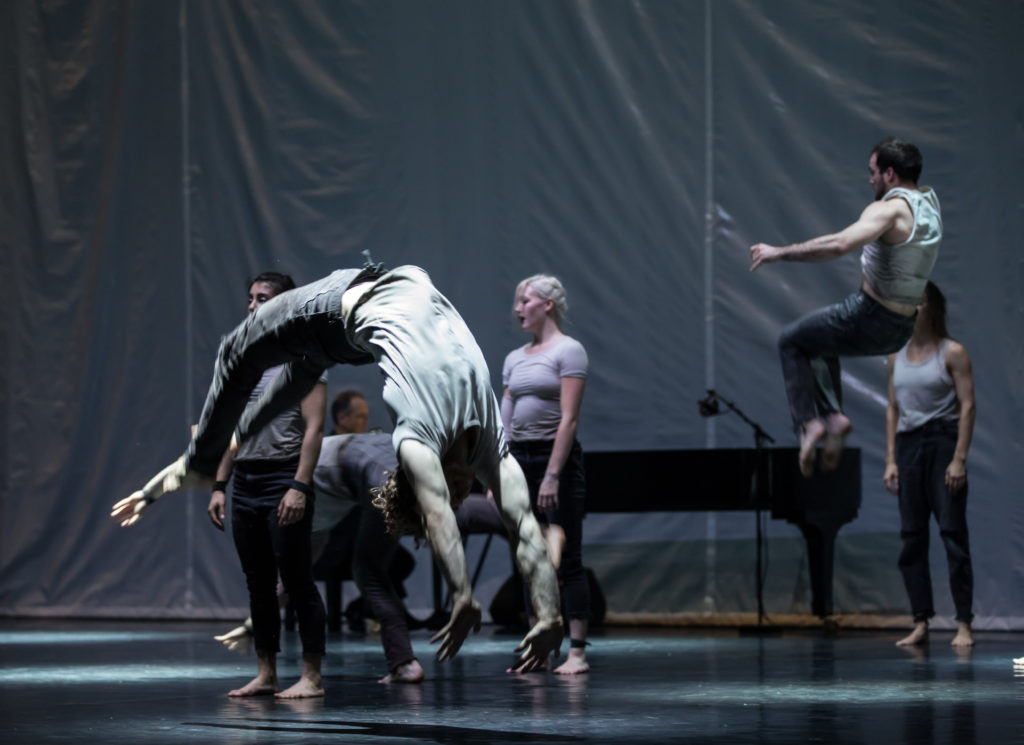Fresh Start and Old Ending? Australian Circus Company Circa Brings Its Second U.S. Premiere to NYC with En Masse
A man (Robert Murray) draped in robes sings a Schubert aria, his knit hat, fingerless gloves and staff in hand suggest that it is some sort of wandering remnant of lost time, grieving the various bodies collapsed on the floor across the stage. As he sings, the bodies begin to roll out of view, save one: a contortionist (Kimberly O’Brian) attempting some sort of distorted self-assembly. She pulls herself apart and pieces herself back together until she approaches the man (who has been mostly ignoring her). She briefly rests her foot on his slumped shoulder as he continues to sing, and then performs a gentle back walkover to the floor before simply standing up and walking offstage with pedestrian ease.
This is the opening scene of Circa’sEn Masse, Australian director Yaron Lifschitz’s most recent work with the prolific and virtuosic company he has helmed for two decades. The show is celebrating its American premiere in Lincoln Center’s White Light Festival, its second U.S. premiere with this festival followingHow Like An Angel in 2014.
In the director’s notes forEn Masse, Lifschitz describes his initial ideas as: “an incoherent gabble about wanting to combineThe Rite of Spring, Schubert’s late songs, electronic music, and the end of the world, the start of a new one, and the behavior of groups in times of crisis- all within an acrobatic and circus show.”
This addsEn Masse to an increasing trend of contemporary circus attempting to contextualize itself as a vehicle for dark, abstract, poetic socio-political commentary. Other recent counterparts include Cirkus Cirkor’sLimits and Raphaelle Boitelle’sWhen Angels Fall.

After the opening scene,En Masse continues to integrate Lifschitz’ noted ingredients (albeit at times in very stripped down and abstracted imagery) and Circa’s signature ensemble acrobatic choreography. The show’s use of costume and set are simple. The set is mostly clear plastic sheets and a large inflated (later deflated) box/cage for the acrobats in part of Act One. The costumes are muted grays and blues. The costumes are a familiar contemporary circus look: jeans and t-shirts. Contemporary circus audiences may or may not raise an eyebrow here. I did, but more on that later.
Whatever you have to say about the dramaturgy and design, the mastery of Circa’s ensemble movement is unarguably one of the most consistent forerunners of contemporary circus as dance-like movement language out there. Similar to the company’s 2013Opus, sections of the show, particularly Act Two’sRite of Spring looks like what can only be described as circus ballet: impeccably timed ensemble hand to hand, partner and group acro, tumbling, banquine, and acrobatic choreography that weaves through itself at times like the flight patterns of birds.
This movement language is set first to the alternating soundscape of Schubert arias and techno music by Swedish musician Klara Lewis and later to Stravinsky’s famousRite of Spring in Act Two. At face value, we do in fact have what Lifschitz describes as “a show in two parts which speaks to fresh starts and old endings, of violence and tenderness, of groups and individuals, of destruction and of abundant hope.” I can’t help but admire the commitment to staging this disjointed puzzle, as well as respect the skill of the exquisite acrobats who do their best to meld their ferocious circus skills with more nuanced movements like twitching, convulsing, and deliberately audible breathing. The gorgeous piano arrangements of Schubert and Stravinsky played live by Tamara-Anna Cislowska and Michael Kieran Harvey, were also expertly performed, as were the vocals by tenor Robert Murray.

Yet somehow, I spent the whole show distracted. I could tell audience members around me were mesmerized. Some of my circus colleagues in the audience were beaming with inspiration when I said hi to them during intermission. I almost felt guilty for the distracted questioning circulating through me. But when the inquiring question bell in my intuition rings, I trust that I am being called to unpack something. A recurring question when I watched the show was, “How is this thoroughly serious quasi post-apocalyptic show by internationally-touring Circa meant to function in the world? Is it an artistic thesis on how the form of acrobatics can be contextualized by ideas, behind a fourth wall, meant to be consumed by the elite audiences who can afford to buy tickets so that contemporary circus can gain high-art status? Or is this trying to be a slight of hand- ‘You think you’re coming to a circus show but surprise! Real urgent stuff is happening out in the world that needs your attention! This is a poetic call to action using world-class circus movement as symbolism to get your blood moving! Now go forth and engage with the world and its needs!’ Because if it’s the former, how is it functioning to address its stated thesis of healing in crisis and advance us towards some sort of collective new beginning?
Confession: I wanted the show to be the latter, a poetic call to action. I came in with high expectations. I had heard Lifschitz pitch the show at Montréal Complétèment Cirque‘s MICC market back in July as deeply serious, topical, and confrontational of our current global disarray. I was excited. As with Cirkor and Boitelle’s work, I wondered how this experienced and established company would use its platform and expertise as an internationally touring contemporary circus behemoth to artistically address the questions plaguing societies on an international scale.
As an emerging artist/activist/advocate myself, I think about this challenge constantly in relationship to my own work, the work I see, and the ecosystems that surround our respective work.
WithEn Masse, I was so ready to deep dive into an artistic unpacking of the puzzle Lifschitz had built. Yet various elements of the show prevented me from fully engaging.
I was first and foremost distracted by the homogeneity of the young, all white cast representing such big social ideas as the end/beginning of worlds and group behavioral dynamics. Ibelieve that this is something of which the company is aware. And while I appreciate that the pool of artists capable of Circa’s choreographic styles is limited to those young people privileged enough to afford years of training and professional circus school, there are real issues all over the world of racism and economic accessibility when it comes to pursuing a future as a professional (read: full salary-making) contemporary circus artist. While I respect the integrity of the clear intentions of this show, and truly believe none of this was meant to be harmful, I have to acknowledge that we, as a field, on all levels of scale, need to get real about our relationship to racial representation,especially when we are endeavoring to communicate big, planet level sociocultural ideas. It’s 2019: we have language, resources, and tools for growth here.
I was also distracted by the costumes, which like I mentioned were jeans and t-shirts. This is a costume choice which, to use an earlier analogy to ballet, is contemporary circus’ pink tights and black leotards. It’s the obvious baseline, used time and time again, that could be considered a neutralizing agent, but to me, represents a missed artistic opportunity. I truly expected the group to be wearing different costumes in Act Two when we were entering what was described in the director’s notes to be a rebirth phase.
When the curtain came down, the audience rose to its feet in applause. An invigorated wave of energy surrounded me and directed itself at the stage. I was of two minds: one was full of admiring, congratulatory thoughts for the choreographic research and skillfulness that I’d just witnessed, not to mention respect for Lifschitz commitment to that initial challenging idea; the other was more disappointed. I wanted the fourth wall to break and/or for the audiences’ awareness of our role, our voyeurship, our removed privilege from the turmoil onstage to be implicated. I wondered about the relationship between the musicians and tenor in relationship to the circus artists and longed for some sort of clearer symbolism. I wanted there to be a significant costume/lighting/set change in Act Two representing a new beginning. I had craved deeper emotional/spiritual commitment to the subject matter on behalf of the performers, whose relationships to each other felt deeply character-less.
The artists definitely seemed at home tumbling energetically amongst techno beats, their soulfulness revealing itself through the spirited energy of their movement. Yet the slow, thick, muscular movement to classical music lost this spirited undercurrent, revealing efforting athletes more than human bodies channeling some sort of poetic message through movement. This discord read more as incongruous casualty of hard athletic work than as a choice in artistic dissonance. For a show about individual and collective behavior, some authentic emotional relationship/point of view to their world on behalf of the artists would have added to the impactfulness of their performance.
This is a real conundrum of contemporary circus– it is such a high-tension physical activity, traditionally more about static poses and dynamic gymnastic feats than it is about fluid movements– so how CAN circus assemble itself into some sort of nuanced, emotional, movement-driven socio-political commentary? The choice to make a circus choreography toRite of Spring, so famously staged by Tanztheater Wuppertal by Pina Bausch in 1975, serves as a useful reference point for this question. Is circus capable of the raw human nuance conjured in Pina Bausch’s version? Does that matter?
We as a field, like the contortionist in the beginnings of the show, are grappling with the task of pulling our art form apart and piecing it back together to serve multiple artistic and social functions in the world.En Masse serves as a sometimes problematic, but altogether useful step forward. Circa didn’t have to add itself to the list of internationally touring contemporary circus companies tackling big ideas with their shows, but here they are doing that at New York’s Lincoln Center, and that’s significant.
Growth requires trial and error, mistakes and reparations, and as Lifschitz himself says, “destruction and abundant hope,” in order to flourish. I am hopeful, that like the contortionist who suddenly snapped into pedestrian ease after such struggle organizing herself, contemporary circus will too eventually find its stride as a practical and artistic context for poetic sociocultural discourse, as long as we keep trying.
All photos courtesy of Circa. Feature photo credit: Damien Bredberg...
Do you have a story to share? Submit your news story, article or press release.







